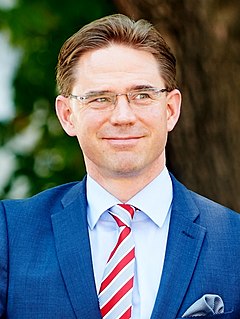The Green League, shortened to the Greens, is a green political party in Finland. The Green League is among the largest political parties in Finland. The Greens hold fifteen seats in the Finnish Parliament and one in the European Parliament. The party is a member of the Global Greens and the European Green Party, while its MEP, Heidi Hautala, sits with The Greens–European Free Alliance in the European Parliament. Originally split on whether Finland should join the European Union, the Green League is pro-European and was the first Finnish party in favor of the federalisation of the European Union.
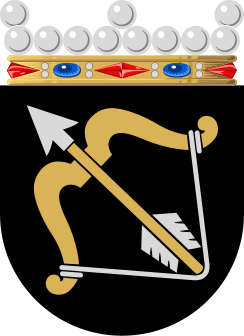
Savonia is a historical province in the east of Finland. It borders Tavastia, Ostrobothnia, and Karelia. In current day, Savonia is divided in two provinces Northern Savonia and Southern Savonia. The largest cities in Savonia by population are Kuopio, Mikkeli, Savonlinna, Varkaus and Iisalmi.

The Finns Party, formerly known in English as the True Finns, is a Finnish conservative political party, founded in 1995 following the dissolution of the Finnish Rural Party.

Timo Juhani Soini is a Finnish politician who is the co-founder and former leader of the Finns Party. He served as Deputy Prime Minister of Finland from 2015 to 2017 and has been Minister of Foreign Affairs since 2015.

Parliamentary elections were held in Finland on 18 March 2007. Early voting was possible from the 7–13 March. The 200 members of the Eduskunta were elected from 15 constituencies.
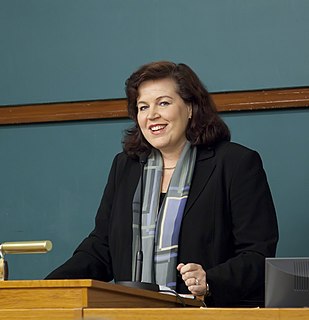
Anne Elisabeth Holmlund is a Finnish politician and Minister of the Interior of Finland from 2007 to 2011. She has been a Member of Parliament for the National Coalition Party since 2002.

Parliamentary elections were held in Finland on 17 April 2011 after the termination of the previous parliamentary term. Advance voting, which included voting by Finnish expatriates, was held between 6 and 12 April with a turnout of 31.2%.

The Katainen Cabinet was the 72nd cabinet of Finland, formed as a result of the 2011 post-parliamentary election negotiations between the Finnish parliamentary parties. Led by Prime Minister Jyrki Katainen of the National Coalition Party (NCP), 12 ministers of the 19-minister government represented the NCP and the Social Democratic Party (SDP), while the Left Alliance, the Green League, the Swedish People's Party (RKP) and the Christian Democrats share seven minister portfolios. On June 22, the Parliament confirmed Katainen's election as the Prime Minister and President Tarja Halonen inaugurated the government. Two Left Alliance MPs voted against Katainen, for which they were formally reprimanded by the Left Alliance's parliamentary group. On 25 March, 2014, the rest of Left Alliance left the cabinet over dispute on a package of spending cuts and tax rises.
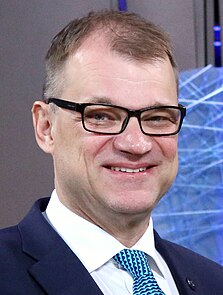
Juha Petri Sipilä is a Finnish politician who has served as Prime Minister of Finland since 2015. A relative newcomer to politics, he has a successful background in business. He has been the leader of the Centre Party since 9 June 2012. After leading the Centre party to victory in the 2015 general election, Sipilä formed a centre-right coalition and was appointed Prime Minister by the Finnish Parliament on 29 May 2015. On 8 March 2019, Sipilä stated his intention to resign as Prime Minister, citing difficulties in reforming Finland's health care system. President Sauli Niinistö has asked him to continue with a caretaker government until a parliamentary election can be held on April 14.

The Stubb Cabinet was the 73rd Government of Finland, which stepped into office on 24 June 2014. It succeeded Jyrki Katainen's cabinet. The cabinet's prime minister was Alexander Stubb.
Following the 2011 election, a new government was negotiated between the leading parties of the Finnish parliament.

The 2019 Finnish parliamentary election is scheduled to be held on 14 April 2019.
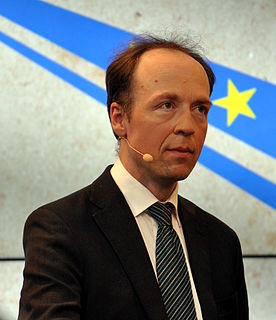
The 2017 Finnish government crisis followed the Finns Party leadership election held on 10 June 2017. Prime Minister Juha Sipilä and Minister of Finance Petteri Orpo announced on 12 June that they would no longer cooperate in a coalition government with the Finns Party after Jussi Halla-aho was elected party chairman. The crisis resolved on 13 June when twenty MPs defected from the Finns Party's parliamentary group, forming what would eventually become the Blue Reform party. Sipilä's government retained a majority in Finland's parliament as the Blue Reform continued as a member of the coalition.

Krista Johanna Mikkonen is a Finnish Green Party politician. She now lives in Joensuu, but spent her childhood in Koria. She has worked as a Member of the Finnish Parliament since 2015. Mikkonen was elected as the Green Party spokeswoman in September 2016. Before that, Mikkonen worked as the party's vice chairman.












